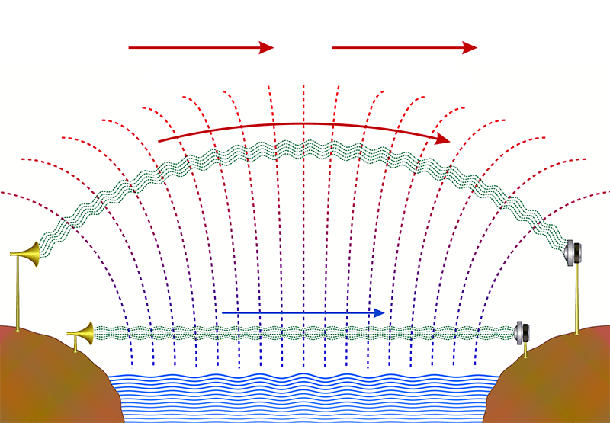An acoustic engineer is an engineer who specializes in the science of sound and vibration (physics). Their primary function is the control of noise or vibration that can affect individuals, and the improvement of the sound environment for the population. The sectors that benefit from expertise in acoustical engineering are numerous and diverse: environmental, architectural, industrial, entertainment, manufacturing, and transportation.
Environmental Acoustics
In the environmental sector, the acoustical engineer works to verify noise compliance of factories, industries, construction sites, and businesses, or to conduct noise impact studies related to the sound environment produced by future or existing installations.
When noise is emitted by factories, industries or businesses, the acoustical engineer makes a measurements and a diagnosis, and gives solutions that allow the installations to become compliant with regulations and/or ensure the tranquility of the neighborhood.
Among the many tools used by the acoustical engineer, there is environmental acoustic modeling software, which can calculate the noise propagation in the environment aroundfactories, industries, or residential areas. This modeling of sound takes into account the effects of weather, buildings, topography, surface properties and the acoustic characteristics of sound sources.
Industrial Acoustics
In industry, noise reduction of sound sources for workers is an important health issue. It is recognized that working environments that are too exposed to noise can lead to occupational deafness, fatigue, and other health issues.
The first step for an acoustical engineer is to make accurate diagnoses of noise problems in these noisy environments. The acoustical engineer seeks to determine the dominant sound sources as well as the solutions that make it possible to reduce the noise nuisance. Acoustic diagnostics in noisy environments require, in addition to the traditional sound level meter, more specialized tools such as sound intensity probes, sound mapping, and beamforming antenna.
The main corrective approaches in industry then take the form of reducing the noise at the source, reducing the spread of noise to affected individuals, and/or directly protect the worker or affected area.

Noise in the Manufacturing Industry
Acoustics are a key consideration for many commonly manufactured products such as automobiles, trains, planes, motorcycles, lawnmowers, appliances, and indeed most other electrical or mechanical products that surround us and are part of our lives.
The acoustical engineer works to quieten the noise-generation within these products, or improve the soundproofing. For example, think of some cars that are very well soundproofed from the noise of the road, this in not just luck, its acoustical engineering. Consumers are willing to pay more for a dishwasher that is almost inaudible in the kitchen.
In some cases, the mandate of the acoustical consultant will be to adjust the sound quality of a product to improve the feeling or perception related to its use. For example, a luxury car door must make a loud thud to give a sense of solidity, or a car deliberately lets in a portion of the engine sound to give a sense of power. In these situations, the acoustical engineer will work in the field of psychoacoustics.
Noise Impacts of Transportation
Transportation sources are one of the most disturbing noise nuisances for all urbanized sectors. Government authorities require the calculation of the noise impacts of new roads, railways, airports and ports. Developers and cities are also required to consider the noise environment of the new multi-unit housing, condos, homes and new residential subdivisions.
The role of the acoustic engineer is to measure, simulate and calculate the sound levels associated with the transport. This approach then makes it possible to determine the mitigation measures required to ensure the tranquility of the communities affected by the transportation projects. The acoustical engineer sets design criteria based on applicable regulations, or recommendations of the World Health Organization (WHO).

Architectural Acoustics
In the architectural sector, the acoustic engineer is called upon to provide advice and studies to ensure acoustic comfort, soundproofing and confidentiality in buildings (residences, offices, schools, shops, cinemas, etc.). The acoustical engineer works with architects, decision-makers, other specialists and engineers to improve the acoustics of buildings.
Here are some examples of common architectural issues:
- Echo or excessive reverberation problems in rooms;
- Acoustic comfort in offices;
- Noise distractions and noise disturbance in office spaces;
- Ventilation noise;
- Soundproofing of walls, windows, building envelopes and other partitions;
- Vibration transfer between rooms;
- Confidentiality in offices or conference rooms;
- Intelligibility of speech.

Optimal Acoustics in the Media and Entertainment Industry
In the entertainment sector, the acoustic engineer works to design and optimise the acoustics of theaters and auditoria, in order to make the acoustic experience of the room more enjoyable for the audience. The acoustical engineer will ensure an adequate room geometry, and propose locations and materials for elements used to control the aural quality of the space throughabsorption, reflection and diffusion of sound. The acoustical engineer will also perform analysis to reduce the noise of the ventilation, and to protect the room from external noises and vibration (mechanical sources, public circulation, , external traffic, etc).
Controlling Vibrations Is Also Part of the Job
In the context of their work, the acoustical engineer is not concerned only with airborne sound. They are also concerned with structure-borne sound waves and vibrational waves, transmitted by solid structures such as building elements, the ground, and pipes.
The acoustical engineer seeks to reduce nuisances such as:
- Vibrations of a mechanical room transmitting to adjacent rooms;
- Vibrations produced by transport like trains or car traffic;
- Shocks or impacts commonly produced in gyms or sports centers;
- Vibration levels that do not meet the standards to ensure the comfort of the human body;
- Vibrations affecting the operators of machinery or equipment;
- Footsteps in residential buildings.
Just think of the residences near a railroad; it is important to limit the vibrations to ensure the comfort of the occupants of these places.
In these cases, the role of the acoustical engineer is to verify whether the vibration levels are adequate according to the use of the inhabited space, and to evaluate the corrective measures to be put in place.
Acoustical engineers are indispensable specialists in solving any kind of noise or vibration problem in the environmental, architectural or industrial sector. The use of an acoustical engineer in all phases of project development is recommended, but particularly early in the design phase. Correcting noise problems after they arise can be twice as expensive, and only half as effective, as the correct acoustical treatments being installed during the design phase.
The expertise of an acoustical engineer allows them to clearly identify the problem and to find adequate solutions to the problems presented to them.



